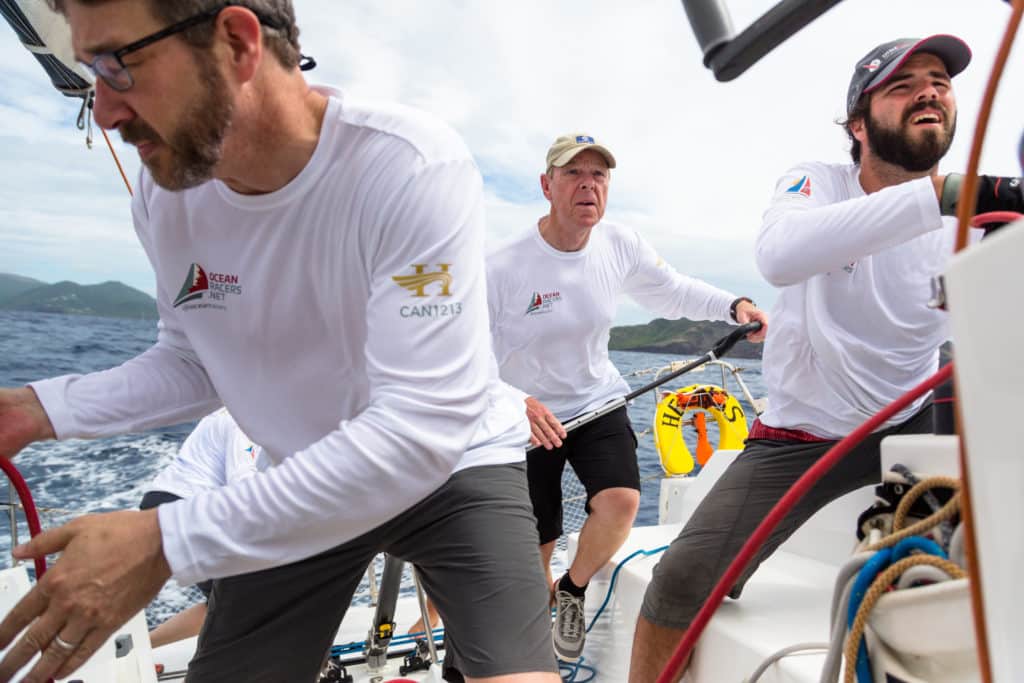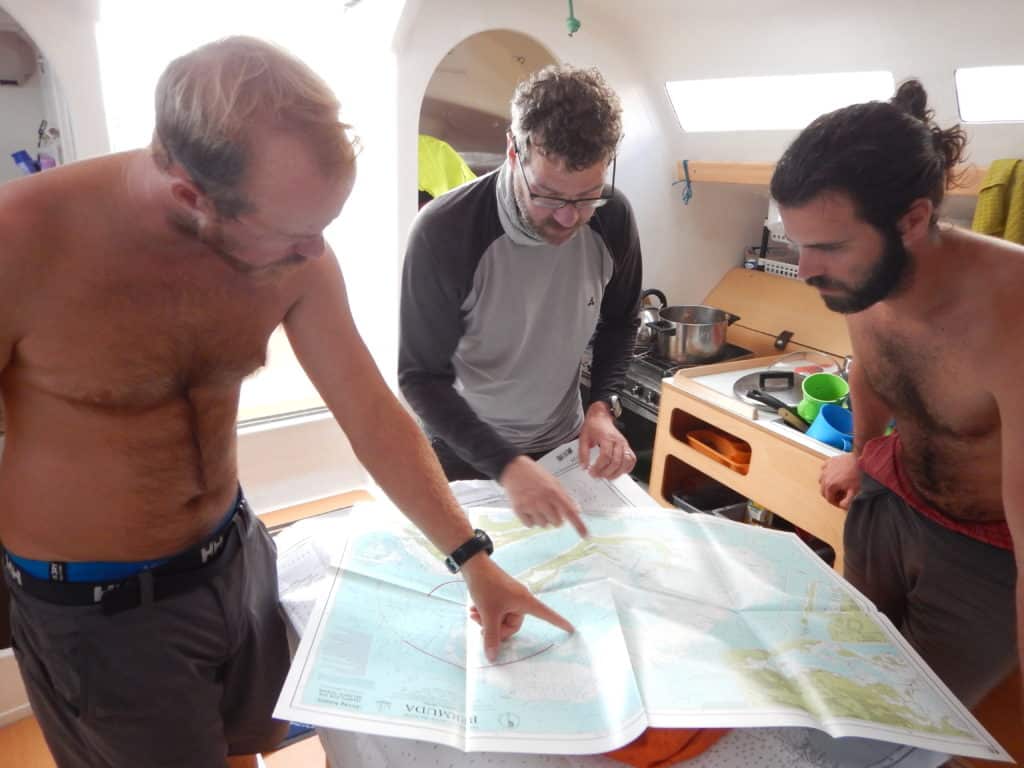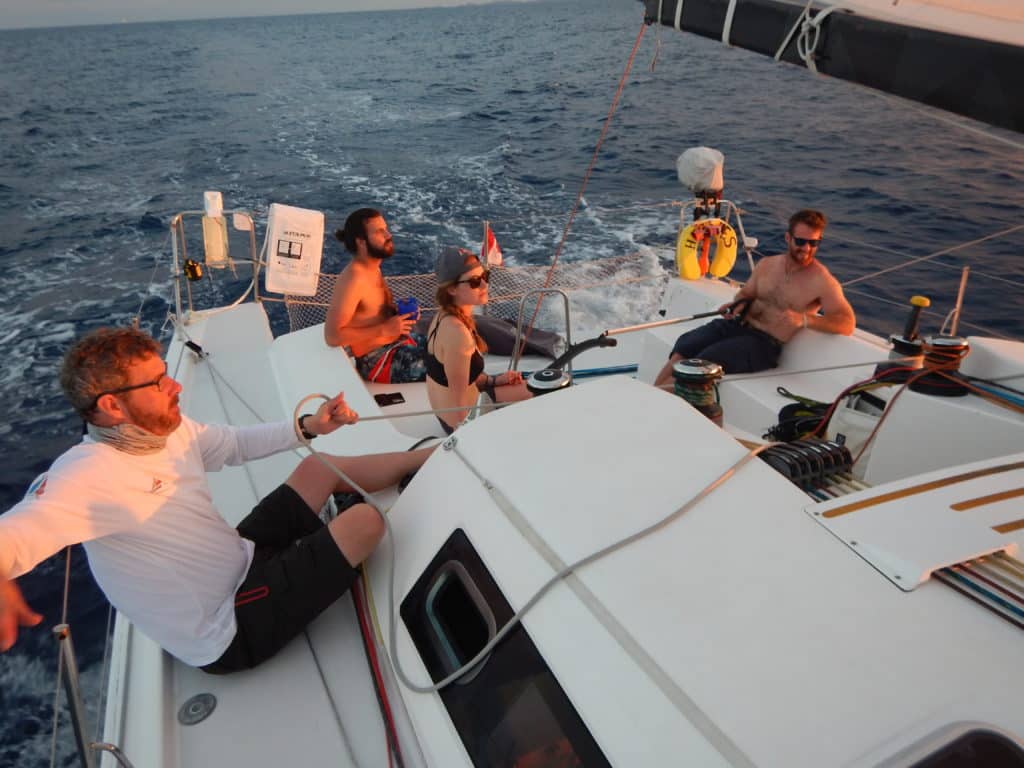
It’s 0100, and we’re more than halfway to Bermuda. We’ve changed from the spinnaker to a jib and have dodged two intense storm cells on the front edge of a long line of weather that we’ve been watching develop in front of us since sunset. The full moon and bright stars of the past four nights since leaving Antigua have disappeared behind the storm clouds. With no visible horizon or clear definition between sky and sea, we’re flying on instruments alone.
Ahead are three much more significant cells, a system too big to circumvent because there’s little wind. On deck are Chris Jones and Olivier LeDuc. Below, in front of the radar screen, watch leader and boat owner Morgen Watson, with partner Meg Reilly looking over his shoulder, calls out headings for a course that should guide us between two of the three cells.
Lightning strikes become more frequent, and much closer as the cells merge into one. The light wind means not only are we moving at a snail’s pace, but the cell is as well, making it difficult to thread the needle on our radar screen. There is no escape route. All we can do is sail a probing, zigzag course through the darkness, hoping to break out somewhere soon. We step over the threshold, into the storm. Lightning strikes obliterate night vision. Torrents of rain begin drumming on the cabin top, and Watson must shout to be heard. As he calls out headings, he yells encouragement up to Jones and LeDuc: “Come on now! I need you to stay focused! You got this!”
The front of the boat disappears from view in the rain.
Amid the simmering tension, Joel Ross, a rigger from Vancouver, calmly patches a small spinnaker tear on the salon table under the green glow of his headlamp. There is concern but no panic. Work must be done, and the recognition that there is nothing to do about what’s happening around us encourages us to press on. By 1:30, the cell is behind us, and the chute goes up again. The next morning, Watson remarks in typically Canadian understatement, “What a night that was, eh?”
We’re aboard Hermes, a Pogo 12.5 and, at 40 feet, one of the two smallest boats in the 21-boat fleet sailing the 935-mile Antigua to Bermuda Race. While veteran Caribbean racers recall a few attempts at this course in the 1970s, most regard this as the inaugural event, one they hope will provide an exclamation point to a highly attended Caribbean racing season and give boats from northern climes an organized event to get them well on their way home. And, of course, there’s the timing, this year at least — the America’s Cup trials start less than a week after the boats arrive in Bermuda.
Hermes, however, is driven by other motivations. Owned by Watson and Reilly, it’s the platform for Ocean Racers, a fledgling operation that provides offshore-racing experience for those who are large on aspirations but short on connections. While there are pay-to-play sailing adventures available for amateur sailors to gain experience, Ocean Racers’ goal is not to just to get people offshore, but to also create a network of offshore sailors that will help launch sailing careers.

“We’re not really interested in doing this for people as a hobby,” says Watson. “There are programs for that, but if you want to work professionally in the industry, we’re here to help you get those miles.”
Watson and Reilly refer to most of their clients as “Aspiring Offshore Athletes” (AOAs), with the intention that those aspirations will eventually be fulfilled.
There are also those who don’t necessarily want to become professional offshore sailors but have specific goals in mind — such as Jones and LeDuc. Jones, a business lawyer from Toronto, sails a Beneteau 36.7 and has been a supporter of the program since the start. For this trip, his focus is navigation, one piece of the offshore puzzle he wants to put in place before taking the plunge on a larger boat with greater offshore ambitions. LeDuc, a hydraulics engineer from Montreal, is an F-18 and C-Class catamaran sailor. “I’ve done deliveries before but never any ocean racing. I’m here because I want to check out this type of sailing to see if it’s something I’d be interested in,” he says when we first meet in Antigua before the start of the race. “It’s a part of the sport I’m really not familiar with.”
The idea of an offshore race training program was born when Watson and Reilly, both 23 at the time, met while sailing in the 2013-14 Clipper Race, an around-the-world race for amateurs. Previous to the Clipper, Watson had experience on tall ships, along with some keelboat racing in Vancouver. Reilly had never sailed before. They parlayed their Clipper Race experiences into a lifestyle business with the purchase of the IMOCA 60 O Canada, nee Spirit of Canada, the boat that Canadian Derek Hatfield sailed in the 2008 Vendée Globe until retiring in New Zealand. They found it sitting on the hard in Vancouver, and Reilly and Watson proposed to form Canadian Ocean Racing, with a mission to develop offshore sailing in Canada in exchange for use of the vessel. Chartering it for two years, paying a dollar a year, they took their show on the road, campaigning the 60 in Vancouver, Halifax, Montreal, Kingston, Toronto and Quebec, and enlisting potential AOAs along the way.
They then set their sites on the world stage, taking O Canada trans-Atlantic to Europe. However, once abroad, their efforts sputtered. By the time the boat was back in Canadian waters, they had concluded the Open 60 was “way too big and too high performance,” says Reilly. This, combined with an unwieldly operating budget and bare-bones accommodations (for instance, there is no head—only a bucket), made clear it was the wrong platform for the program.
“That’s when we decided to invest in the Pogo 12.5, which is still a high-performance boat. We can race it, but it has some creature comforts,” says Reilly. Along the way, they discovered other advantages to a scaled-down operation.
“I like to get everyone involved in every aspect of the sailing,” says Watson. “It provides team building, better cohesion, and provides [our clients] with a little different experience. If we were running a boat with a crew of 15, that just wouldn’t be possible.” Hermes carries a maximum crew of six, which opens up participation possibilities for everyone aboard. “At the end of the day,” says Watson, “it’s about them having a good time and learning something — even if it’s not something about sailing. Maybe they learn something about themselves. Sure, we love to finish on the podium, but having a good time and learning something is really the bottom line.”

Watch them at work, and you’ll see what Watson is talking about. En route to Bermuda, all tasks are shared, and we can do as much or as little as we want, except for cooking dinners, which is Reilly’s domain. LeDuc puts in a lot of time on the helm and contributes to sail trim, as do I, while Jones and Watson frequently huddle around the computer or chart, focusing on navigation. Ross also does his share of steering and helps out with rigging maintenance. One light-air afternoon, Ross is prepping the main halyard for end-for-ending once the trip is over, and with a simple inquiry from LeDuc about eye splices, the cockpit turns into a classroom on splicing. The learning continues with every mile.
Apart from transitioning to a more manageable and more productive platform, Watson and Reilly expanded their marketing efforts beyond Canada, a shift signaled by rebranding the program as Ocean Racers but with continued focus on AOAs. Ross is one of their success stories. A former catcher for Quebec’s professional baseball league, he joined the program in the O Canada days and sailed the boat trans-Atlantic. He’s gone on to do the Caribbean 600 and Fastnet Race, and he and Watson have their eyes set on doublehanded offshore races in an Open 40 — if they can find the funding.
“The biggest obstacle is that we’re young,” says Reilly. “People might think we’re inexperienced because of our age, but Morgen and I have almost 200,000 nautical miles between us, so we actually have more experience than most. Because we’re developing this on our own, that created challenges, especially when it came to find funding.”
But there are miles, and then there are miles.
“Naiveté was our best asset,” Reilly adds. “Looking back, we didn’t know how difficult it would be.”
But because Reilly and Watson weren’t able to acknowledge — or perhaps refused to acknowledge — any limitations, the sky became the limit. They knew there were a lot of people, like themselves, who were seeking opportunities. At first glance, Watson and Reilly represent the epitomic odd couple of sailing. She is the firebrand, a New Jersey native with a broad smile, brimming with assertive confidence and eager to take on the world. And yes, she really did sail the Clipper Race with no sailing background. The boat she was on won it, making her the youngest female sailor to win an around-the-world race. The one you’ve never heard about. She bills herself as a “marketing executive and entrepreneur,” and uses those skills to keep the Ocean Racers organization on track.
Watson, on the other hand, looks like an ocean racer — a solid build with sun-bleached hair and trimmed beard. Soft-spoken, he’s a hard-working boat technician able to maintain razorlike focus on problems, but also capable of breaking into infectious laughter at the drop of a hat. At 27, both maintain a millennial aura of unbridled enthusiasm, and with cellphones almost permanently in hand, they’re always connected to each other and the world.
Despite its name, Ocean Racers is not limited to just racing experience, as the program offers slots aboard for passage-making as well. “We have a woman who’s doing the passage from Bermuda to New York with us,” says Watson. She was originally looking to race, but she’s never done a lot of offshore, so I suggested she step back, do this passage with me, and then we’ll come back and look at racing.”
He has three others with him for the delivery as well. “Cruising is quite different. I do a lot more coaching and training, which is what I did with the Clipper [Race],” he says.
Watson and Reilly readily acknowledge the business itself has been no easy passage.
“If I knew in advance that I was going to be living on a boat and eating peanut butter and jelly sandwiches and barely making it financially, I probably wouldn’t have done this,” says Reilly. “But even so, it’s a great experience. It helped us in the sense of believing we could do it, and it helped us through challenges because we didn’t know that we couldn’t.”
As soon as we set foot on the docks in Bermuda, Reilly and Watson have a chance encounter with a veteran ocean racer who encourages them to make a run at the Volvo Ocean Race. Phones appear, numbers are crunched, calendars cross-checked, and excitement skyrockets. The Open 40 plan dissipates like morning fog. On the horizon, there’s a new mountain to climb, and if the duo’s track record is any sort of indicator, they’ll eventually find a way to get there.









